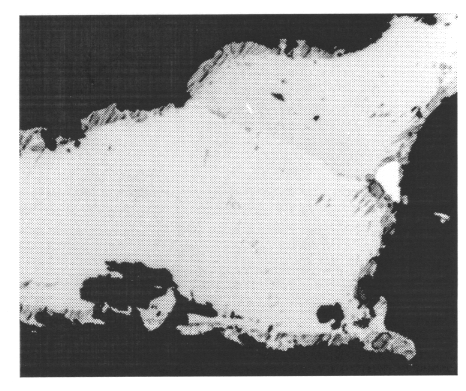

Pyrrhotite is the most abundant magnetic ore mineral in the paragneissic and metabasic rock suite of the continental crust sampled by the German continental deep-drilling project (KTB), in which it formed by pre-, syn- and postmetamorphic phases of mineralization. A range of pyrrhotite structural types occur throughout the 9101 m depth of the bore hole (temperatures up to 260 °C), showing different optical, magnetic and chemical characteristics. Deep drilling through a natural pyrrhotite-bearing continental crust should reveal important information about in situ pyrrhotite stability and magnetic properties, especially for temperatures below 300 °C where a variety of structure types can exist. Previous studies have shown that these natural pyrrhotites have ferri- and antiferromagnetic properties and contain microscopic magnetic domains. In the present investigation, we use transmission electron microscopy (TEM) to correlate microstructures with optically-observed magnetic domains to better understand the magnetic properties of natural pyrrhotites.
The crystal structures of troilite (FeS) and pyrrhotite (Fe1-xS) are based on the hexagonal close-packed NiAs structure, where the S atoms form a hexagonal close-packed sublattice and the iron atoms occupy the interstitial octahedral sites. The non-stoichiometry of pyrrhotite causes a deficiency of iron atoms in the Fe layers. As a function of composition and temperature, ordering of the iron vacancies produces multiple superstructures of the NiAs-type subcell with varying magnetic properties. Because the superstructures of pyrrhotite mostly depend on the stacking sequences of the (001)-Fe layers in c* direction, it is necessary to use c* diffraction information for the identification of pyrrhotite superstructures.
Material from depths > 8500 m (in situ temperatures of > 240 °C) contain both the hexagonal antiferromagnetic and monoclinic ferrimagnetic pyrrhotite types. The monoclinic pyrrhotite occurs predominantly as narrow ferrimagnetic rims around grains of the hexagonal antiferromagnetic pyrrhotite. Optical, thermomagnetic, and structural investigations confirm the dominance of hexagonal intermediate pyrrhotite in the samples. At these depths (T > 240 °C) the ferrimagnetic NA-pyrrhotite type should be the stable in-situ pyrrhotite phase. It appears that the NA-pyrrhotite transformed into the low-temperature hexagonal 5C-type during the temperature and pressure decrease (from 260° to 80 °C) that occurred while lifting the drilled samples to the Earth's surface.
The samples recovered from depths < 8500 m also contain microstructures indicative of phase transformations, but such transitions cannot be explained by drilling because many were within the stability fields of the low temperature forms. Samples from relatively shallow depths (565 and 2500 m) consist of predominantly the monoclinic 4C type and hexagonal 2C troilite with minor amounts of the intermediate 5C, 6C, and nC types. Mixed phases and twinning in 4C pyrrhotite indicate that the material experienced a phase transformation, probably during the tectonic uplift. During such uplift, the pyrrhotites would have had sufficient time to transform to the most stable 4C and 2C forms.
Microstructural investigations of the ferrimagnetic rims of pyrrhotite
grains with antiferromagnetic cores show a domain structure consisting
of nanometer-scale intergrowths of monoclinic 4C-, hexagonal 5C-, 6C-,
and nonintegral nC-pyrrhotite types. In addition, there are twin domains,
stacking faults and locally high densities of dislocations. The antiferromagnetic
domains consist predominantly of the hexagonal 5C-, 6C-, and nC-pyrrhotite
types. The intimate intergrowth of monoclinic and hexagonal pyrrhotite
explains the low metal content (ave. 46.5 atom%) of the antiferromagnetic
cores in the sample from 564.65 m depth (Fig. 3.4-1), determined by microprobe
analysis.
 |
Fig. 3.4-1: Pyrrhotite from 564.65 m depth of the KTB VB (sample 104C4a, graphite-bearing biotite gneiss) displaying ferrimagnetic rims around antiferromagnetic cores when covered with a magnetic colloidal fluid. Within the cores, a lamellar ferrimagnetic pattern occurs in the antiferromagnetic matrix. |
Samples with optically-observed ferrimagnetic or antiferromagnetic domains
have monoclinic thermomagnetic behaviour and show little compositional
variation. Bright field images and electron diffraction of these magnetic
domains showed that the crystals consist of the monoclinic 4C superstructure
with twins. Twin boundaries are sub-parallel to the (001) plane and are
sometimes coupled with stacking faults and dislocations (Fig. 3.4-2). Twinning
coupled with deformation microstructures suggest that the monoclinic pyrrhotite
may have formed from a higher symmetry type through a phase transition
under stress.
 |
Fig. 3.4-2: Bright field TEM image of 4C pyrrhotite displaying a narrow twin lamellae. The twin is in a [010] zone axis orientation whereas the surrounding matrix is in the [ |

Tel: +49-(0) 921 55 3700 / 3766, Fax: +49-(0) 921 55 3769, E-mail: bayerisches.geoinstitut(at)uni-bayreuth.de
 Previous page
Previous page
 10] orientation.
The lower twin boundary is connected to a wall of dislocations and stacking
fault, suggesting that the twinning may be realted to deformation.
10] orientation.
The lower twin boundary is connected to a wall of dislocations and stacking
fault, suggesting that the twinning may be realted to deformation.